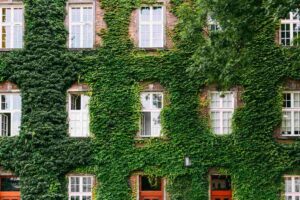The business case for green buildings is compelling. But design fees and long construction times are an up-front hurdle.
There’s a clear business case for building green.
That’s the message from the most comprehensive study to date of the marginal cost of green construction, focused on the commercial property market in the United Kingdom.
Researchers compared 336 green-certified buildings to some 2000 non-certified construction projects built between 2003 and 2014, matching projects on construction dates and county location.
They found that green buildings cost 6.5 per cent more to develop on average. However, such buildings have been shown to rent for 13.3-36.5 per cent more.
“Building green has a clear benefit for developers, investors and lenders, and owner/occupiers,” said Nils Kok, part of the research team with Andrea Chegut and Piet Eichholtz. Kok is associate professor at University of Maastricht and chief economist at property valuation firm GeoPhy.
Kok spoke to NBS with Jonathan Flaherty, senior director for Sustainability and Utilities at real estate developer Tishman Speyer in New York.
Kok and Flaherty agree: Building green makes economic sense, but it has upfront costs, particularly around design fees and construction time. It’s not clear whether those costs will soon diminish.
The business case for green buildings matters
Green buildings aim to positively impact the natural environment in their design, construction, and operation. That’s an important goal: buildings and construction represent 39 per cent of global carbon emissions.
Yet green buildings represent just a small percentage of total building stock. For example, in 2019, 13.8 per cent of commercial office stock in the 30 largest US office real estate markets was environmentally certified.
“In order to convince people to do things, you need to show the real data,” said Flaherty. “This [research] is the evidence someone needs to convince their investment committee to allow them to spend 5 per cent more on design fees, because it increases the actual rent returns.”
Building green provides overall value, despite variation
The business case for green building should apply in most developed markets, Kok told NBS. “Whether in London, New York, Singapore, Sydney, or Toronto, studies show that green-certified buildings sell at slightly higher prices, rent at slightly higher rates, and typically have occupancy that is a little higher.” (In emerging markets, green buildings may have different costs and returns, due to other market dynamics, Kok said.)
The higher occupancy rate for green buildings is especially appealing to developers, said Flaherty. With his firm’s green buildings, “we’re much more interested in velocity [of renting] than we are in the actual rent number per se. We think that it’s much more valuable to us to never have vacant space.”
While 6.5 per cent is the average additional cost for green building, precise costs will play out differently for different projects. “Developing in different markets has vastly different costs even within the United States,” Flaherty explained. Different locations have different labour markets — e.g., union involvement — and access to materials. As a result, buildings in different cities, even if “literally identical down to the last nail,” will be built “by different trades and different sequences and different ways.”
Certification levels have different impacts
Building costs also vary by green certification level. The researchers studied buildings certified through the BREEAM label, the most widely adopted environmental certification system for buildings in the UK. Like many green building certifications, the BREEAM program has multiple levels, from Pass to Outstanding.
Most green buildings in the UK – 82 per cent — are rated either BREEAM Very Good or Excellent. These are 5-19 per cent costlier to construct than noncertified projects. By contrast, buildings at the lowest levels of BREEAM green certification (Good and Pass) have no environmental cost premium. The “green premium” that certified buildings can achieve also increases with the certification level, Kok noted.
Upfront costs for green building are an obstacle
The higher cost of green building comes from two specific construction cost elements, the researchers found. These are (1) design and (2) fittings and finishes, such as lighting and flooring materials. Green building design costs are 32 per cent higher than the costs of conventional building design, and fittings and finishes costs are higher by 32 and 28 per cent.
While design fees are only 3 per cent of overall green building costs, they pose a particular obstacle to green construction, the authors write. Developers pay design fees early on, when ultimate project success is uncertain.
“Design costs have an outsized impact on the construction practices ultimately,” Kok told NBS. “For developers, it’s like, “Oh, whoa. That’s what I pay upfront before I get a construction loan — my own money goes into a design set and a plan that I can then take to prospective tenants, investors, or owner occupiers for them to take that building off my balance sheet.’”
Green building construction also takes 11 per cent longer than construction of a conventional building of comparable size, the researchers found. As a result, builders wait longer for cash flow from rentals or for the project to be sold. The average internal rate of return (IRR) for the developer is 2.6 per cent lower (on a relative basis) on a green certified project.
Will green design get cheaper?
Kok thinks that learning and competition will eventually drive down both design costs and the longer construction time. He compares these challenges to green building consulting: “That went from niche and expensive to something that many parties in the market can now provide. And the same, I think, is happening with design and construction. It’s become more common to integrate energy efficiency and other sustainability features into the design, but it’s still emerging. Not all architects and design firms are well versed in that.
“Design as a profession is not something that changes overnight,” Kok added. “It’s a broad field. People engage in continuous education, but some of these things are fairly novel. Still, to me, there’s no doubt that costs ultimately will be compressed because green design shouldn’t be more expensive.”
Flaherty is less optimistic about the uptake of new approaches. Green design and construction are complicated, he says, and relevant fields — architecture and engineering — aren’t structured to meet the challenge. “Architecture and engineering are highly fragmented businesses with lots of sole proprietors,” he said. “It’s really, really complicated to design a LEED platinum one million square foot office building. The regular architecture firms and mechanical engineering firms out there cannot build you a triple glass paned facade or a heat recovery system or any number of [green elements].”
Spreading that knowledge will happen slowly, he predicts: “In small firms, they don’t have the cash flow to have people going to conferences and spending hours going to online seminars and learning.”
Green building benefits occupants as well as developers
Beyond financial returns, green building has health benefits for occupant, Kok has found in other research. Green buildings have better air quality — e.g., materials that are not offgassing — and stimulate occupants to move, e.g. via accessible staircases.
These findings on employee well-being may be especially relevant now. “With the COVID-19 pandemic, that notion of health and buildings is central,” said Kok. “On the one hand, buildings are a cause [of the spread]; on the other hand, they can be a preventative mechanism.
“If we press on the same elevator buttons or sit too close, that could spread disease. On the other hand, buildings that have high quality air filtration, which green buildings typically have, can really influence your health. I think that post COVID-19, more and more companies will say, “If we have our people in buildings” — which will eventually happen again — “how can we make sure that we keep them healthy?”
Read the research
Chegut, A., Eichholtz, P. & Kok, N. 2019. The price of innovation: An analysis of the marginal cost of green buildings. Journal of Environmental Economics and Management, 98,(free access)



Add a Comment
This site uses User Verification plugin to reduce spam. See how your comment data is processed.This site uses User Verification plugin to reduce spam. See how your comment data is processed.